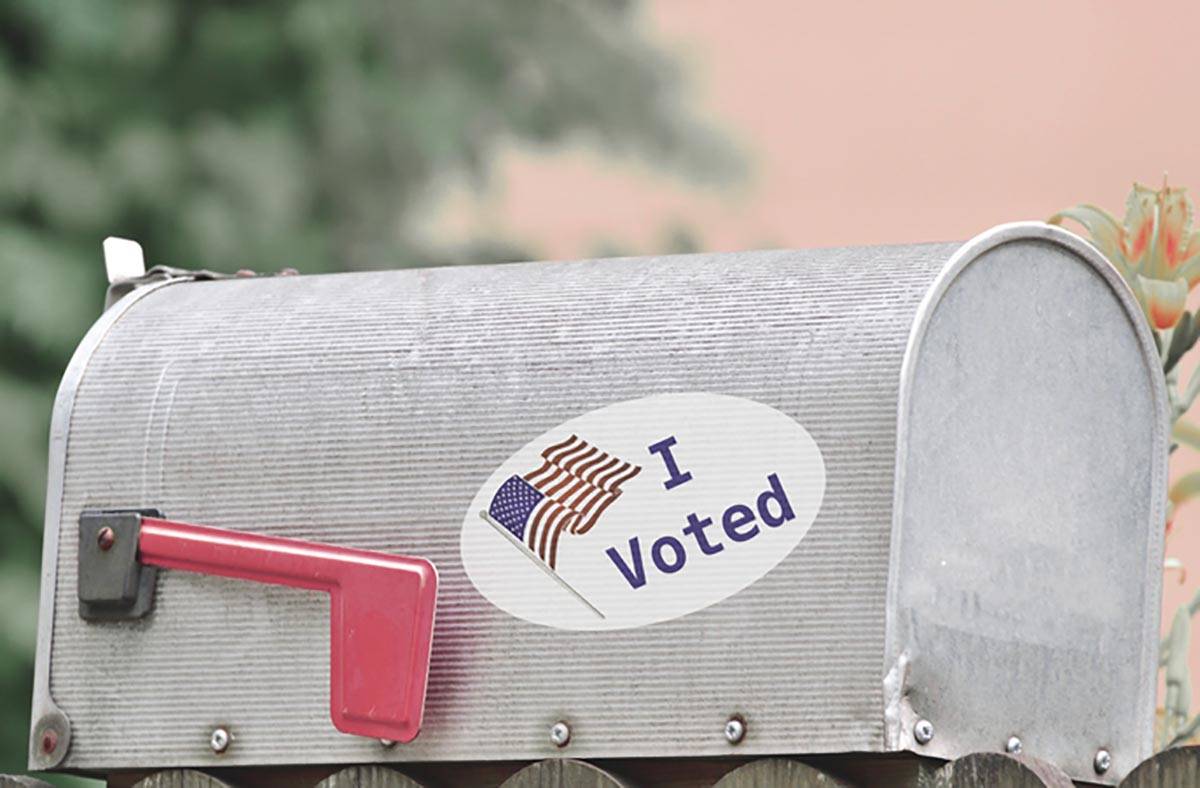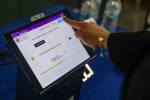Here’s how much it would cost for Americans to vote by mail
For hundreds of millions of Americans, navigating life in a pandemic is completely uncharted territory. There are new ways to work, new ways to grocery shop — even the age-old standard for handwashing has changed. (It used to be the “Happy Birthday” song twice. Now, it might as well be “My Heart Will Go On” on a loop). But, what about voting?
Many Americans are hoping to cast their ballots by mail in the upcoming election, but not everyone is on board with this idea — President Donald Trump has been an especially vocal critic. On April 11, Trump tweeted that voting by mail “substantially increases the risk of crime and voter fraud.” However, fact-checking website Snopes.com rates that claim as “Mostly False,” and many experts say there are security measures taken that make the mail-in system legitimate.
Less than a month after Trump’s tweet, the United States Postal Service Board of Governors installed Louis DeJoy, a Republican fundraiser and political operative, as Postmaster General, Popular Information reported. DeJoy has since been accused of sabotaging the USPS by removing sorting machines and physical mailboxes and has cut work hours and eliminated overtime leading to mail being delivered late. Although DeJoy claimed that these moves will increase the USPS’ performance around mail-in ballots, letters sent by the USPS to 46 states and Washington, D.C. warned that it cannot guarantee all ballots cast by mail for the November election will arrive in time to be counted: “Even if people follow all of their state’s election rules, the pace of Postal Service delivery may disqualify their votes.”
On Aug. 18, DeJoy released a statement saying, “The Postal Service is ready today to handle whatever volume of election mail it receives this fall,” and that he would pause any further planned reforms of the USPS until after the election.
In spite of the current issues with the USPS, if all states were to adopt mail-in ballots, what would it look like? It would certainly come with a cost to taxpayers. For this study, GOBankingRates looked at a report from the Brennan Center for Justice to find out just how much it would cost the United States to implement nationwide mail-in voting. The study is ranked by the smallest dollar figure to the largest and analyzes every measure that would need to be taken to change the way Americans vote.
According to the Brennan Center, revamping the voting system wouldn’t mean everyone has to vote by mail. Much of the estimated cost actually comes from fortifying existing polling locations. But what this revamp would do is ensure that every registered voter has the option to vote by mail, should they elect to do so.
So take a look at how you may be casting your ballot this November — and how it could impact America’s pocketbook.
The status of mail-in voting across the country
Five states already implemented all-mail voting before the pandemic, including Colorado, Hawaii, Oregon, Washington and Utah. Four more states — California, Nevada, Vermont and New Jersey — have since sent ballots to all registered voters, USA Today reported. Nearly all other states are allowing voters to request a mail-in ballot, with the exception of Indiana, Louisiana, Mississippi, New York, South Carolina, Tennessee and Texas — though New York is likely to pass legislation imminently that would allow fear of contracting or spreading COVID-19 to count as “illness” for mail-in ballot requests.
40 cents: The cost of 1 provisional envelope
A provisional ballot is just a regular ballot placed inside a special envelope to indicate its status. This is provided to voters whose voting eligibility is up for question — they may have registered but aren’t showing up in the registration list or haven’t received their ballot in the mail for whatever reason. These envelopes help ensure that everyone has equal access to vote.
The Brennan Center says that jurisdictions should prepare for an increased amount of provisional voting due to delays in voter registration. This will cost 40 cents per provisional envelope, or $21 million total.
80 cents: The average cost for a voter to return their ballot
The Brennan Center looked at the cost for every voter to return their ballot once they’ve recorded their vote. Using an average of 80 cents per ballot, the cost for prepaid postage for everyone in the U.S. comes out to $170 million.
$1.15-$2: The cost of mailing a ballot to a registered voter
If snail mail is dying, this could be why. The simple action of mailing voters their ballots costs $1.15 to $2 per person, which comes out to between $243.45 million and $423.4 million overall.
$1,680: How much is needed for each additional ballot processing worker
Due to the increase in mail-in ballots, more staff will be needed to process these ballots as they come in. This seasonal position lasts for 14 days, at an hourly rate of at least $15 for eight hours a day.
Find out: 25 experts’ predictions on when we will bounce back fromCOVID-19
$3,000-$4,000: Annual cost of operating and maintaining a drop box
Drop boxes are a key part of the vote-by-mail process; this way, even if voters aren’t visiting a polling center, they can vote on the day of the election and know that their ballot will still be counted. In a nonpresidential election year, Snohomish County, Washington, estimates that $3,000 goes into maintaining — just maintaining — a single drop box. In presidential election years, that amount goes up to $4,000.
$7,000-$10,000: Cost of buying and installing a drop box
Based on estimates from the company Laserfab — who made ballot boxes for Pierce County, Washington — a single ballot box could cost as much as $10,000 to build and install. These boxes come equipped with security measures, such as cameras, and are placed in accessible locations for voters to drop off their ballots directly.
$50,000: The cost for ballot tracking software in each state
According to the Brennan Center, around 25% of states already use ballot tracking software — that is, software that can track the progress of a ballot and notify the voter when it is counted.
$240,000: Price for each state to implement online voter registration
A 2014 survey by the Pew Charitable Trusts found that most states that implemented online voter registration spent about $240,000 in startup costs. It can be assumed that higher population states will spend more on voter registration systems, and lower population states will spend less.
Prepare now: What the 2020 election could do to your stock portfolio
$2.1 million: How much it costs to increase voter resources
In order for everyone to have equal access to voting, they need to have resources to know how to do it properly. This includes tools for them to look up their registration status and nearest polling centers. Overall, implementing these tools should cost $40,000 per state, including the District of Columbia and Puerto Rico.
$3.7 million: Amount needed to provide online ballot delivery services
Online ballot delivery services allow voters to mark their ballots on a computer before printing them out, which is integral to voter accessibility — many disabled voters need this function to vote by mail. Providing it will cost each state around $100,000; although 25% of states already have it.
$4.2 million: What it costs to track all the ballots
Ballot tracking gives voters confidence that their vote really does matter — but it comes at a price. It will cost more than $4 million in total for every registered voter in America to receive a notification that their ballot has been counted.
$16.7 million: Cost for online ballot requests
In a safe and accessible voting system, voters should be able to request a ballot in person, by mail, by phone or online. That last part is key, and it’s what many states still don’t have. The cost of this application is estimated at around $325,000 per state.
Voting isn’t the only thing changing: 30 ways shopping will never be the same after the coronavirus
$29.2 million: Cost to bring polling facilities up to public health standards
Even with the option of mail-in voting, in-person voting is still vital if the U.S. wants to promote equal access to voting. However, existing polling locations will need to be sanitized to ensure safety during the pandemic. Voters may also need to use single-use ballot-marking pens, which cost 50 cents apiece.
$37 million: Costs to expand early voting
Expanding early voting is key to reducing lines and administrative stress on Election Day. According to the Brennan Center, there are currently 20.7 million registered voters who live in states without early in-person voting.
$40 million: What it costs to hire new poll workers
Polling stations need to work like well-oiled machines in order for voters and workers to feel safe this upcoming Election Day. To plan for an increased amount of day-of absences, around 20% more staff will need to be hired.
$43 million: Bill for Interpreter Services Over Phone
Multilingual workers are a staple at polling locations. But as mail-in voting is implemented nationwide, interpreter services will need to be offered via phone, as well. This would cost around $700 a day for each precinct.
From RBG to Chief Justice Roberts: Which Supreme Court justice is the richest?
$54 million-$89 million: Cost for nationwide ballot printing
With everyone voting by mail, the number of ballots, absentee envelopes and other materials needed will invariably go up. The Brennan Center pegs the cost of printing a single ballot between 21.4 cents and 35 cents and estimates that each jurisdiction will need to print enough for 120% of registered voters.
$82.2 million: Cost of testing online voter registration systems
As online voter registration systems are expanded across the U.S., Americans may start to experience tech issues that hamper their ability to register. To nip this in the bud, these systems will need to be tested to make sure they can handle surges in web traffic. Capacity testing will cost $25,000 to $60,000 per jurisdiction, and vulnerability testing will cost $80,000 to $100,000.
$85.9 million: Total cost of online voter registration
The total price tag for every American to be able to register to vote online is nearly $86 million. This includes the price of developing new voter registration systems for states that don’t have them and working out the kinks before election time rolls around.
$92 million: Price of new facilities to store and process ballots
An increase in mail-in voting means an increase in, well, mail. Jurisdictions will have to lease additional commercial spaces for at least 60 days to store and count the absentee ballots. In smaller voting districts, the rent is estimated at around $5,000 a month. For bigger districts, this price is doubled.
$100 million: Costs to give pay raises to existing poll workers
Not only will more poll workers need to be hired, but the pay for existing workers will need to be raised. This basically serves as hazard pay — an incentive for them to work the in-person polls, despite the risks. The Brennan Center estimates that pay would be increased from $100 to $200 a day.
$117 million-$164 million: Total cost for drop boxes
For a fraud-free and accessible voting experience, every jurisdiction in the country needs to provide voters with secure drop boxes for ballots. California, Colorado, Oregon and Washington already have this system in place. The Brennan Center estimates that 11,666 drop boxes are needed to cover the states without drop boxes.
$120 million-$240 million: Price to improve absentee ballot processing
The way that ballots are processed has evolved over the years and includes the use of signature verification technology, high-volume mail processing and sorting equipment, as well as high-speed ballot scanners. To accommodate the rapid increase of mail-in ballots, most jurisdictions will need to purchase more ballot-processing equipment.
$164.6 million: How much is needed for new ballot processing staff
Even though ballot processing isn’t entirely manual, it’s not entirely automated, either. New workers will have to be hired to help process the ballots and duplicate them on the stock required for tabulation.
$250 million: Cost of public education campaigns for the new voting system
Only five states are currently using mail-in voting as the primary way to vote. So the rest of the U.S., including D.C., will need to launch campaigns to educate voters on how the mail-in system works — including changes to voting rules and registration, and advertising in non-English languages.
$252.1 million: Total cost of educating the public on safe voting practices
The final price for educating people on how to vote during a pandemic is over $250 million. But it’s necessary to bypass much of the fear-based misinformation that goes around in times like these.
$271.4 million: Total cost of maintaining in-person voting
It’s not cheap to keep voting safe. The Brennan Center predicts that cleaning supplies will cost about $20 per precinct, and polls across the nation will need to hire new staff, increase the wages and expand early voting.
$413 million-$593 million: Total cost for free postage
Sending and receiving ballots isn’t cheap. For everyone to have fair access to mail-in voting, the postage needs to come at no cost to the voters; but this also increases the price tag by about a half-billion.
$982 million-$1.4 billion: Total cost for everyone to be able to vote by mail
The Brennan Center warns that not everyone will be voting by mail come November. As seen with the Iowa Democratic caucus in February, relying on an entirely new system can cause just as many issues as using an outdated one. But, in order for mail-in voting to be an option nationwide, it will likely cost over $1 billion.
$4 billion: Amount Congress should allot to revamp the U.S. voting system
The Brennan Center recommends the government set aside $4 billion to make sure “all elections between now and November are free, fair, safe and secure.” The center originally estimated that it would cost $2 billion nationwide, but realized that states and localities would need more resources to fully adapt their systems and procedures.
While $4 billion is nothing to sniff at, it may be a small price to pay when determining the next four years of America’s political future.
All figures in this article come from the Brennan Center for Justice’s 2020 report Estimated costs of COVID-19 election resiliency measures.
More from GOBankingRates
50 easy things you should do to save money
25 ways to save 20% more of your paycheck without even trying
40 money habits that can leave you broke
Gabrielle Olya contributed to the reporting for this article.
This article originally appeared on GOBankingRates.com: Americans want to vote by mail — here’s how much it would cost




























